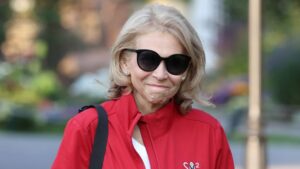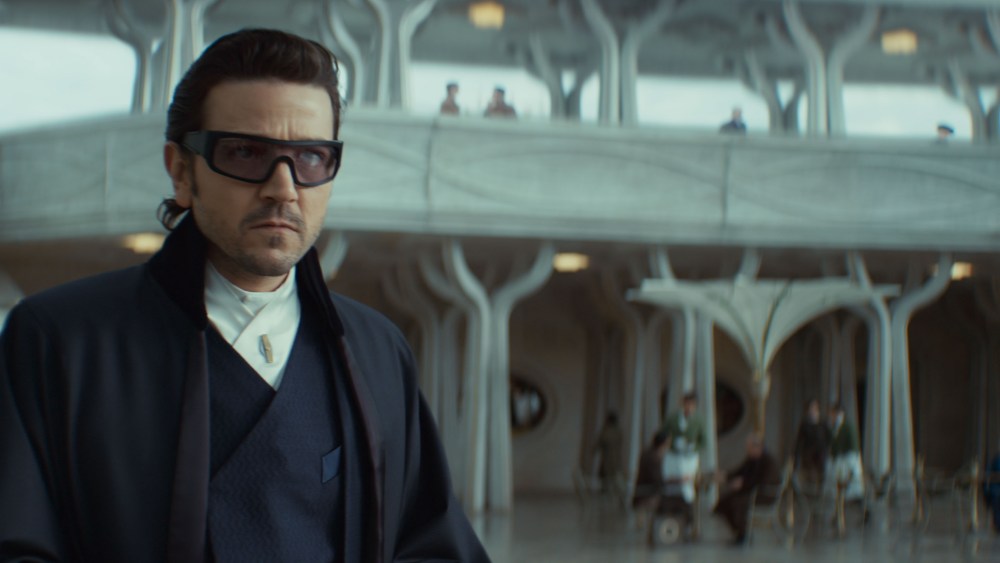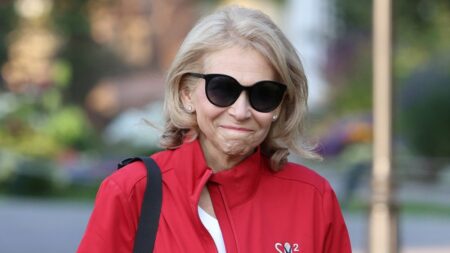“Andor” executive producer and production designer Luke Hull was embedded in the writers’ room early on. Working alongside creator Tony Gilroy, Hull knew how important the planet Ghorman would be to the show’s second season and the “Star Wars” world.
Until now, Ghorman was known to fans as the place where the Empire inspires a new wave of rebel backlash that leads to a massacre — two years before the events of “Star Wars: Episode IV — A New Hope — and strengthens the Rebel Alliance. Hull was tasked with building what had up to this point been an obscure planet.
Its concept was laid out early: Ghorman would be a big city, rich in history and culture, and needed to be a society with a political pull in the senate. It would be a single-product economy — Ghorman twill, known to be the best in the galaxy, and spun by spiders, or ghorlectipods, housed in webberies on the planet.
Hull looked to older architecture as his base because it would give Ghorman a sense of history, and was inspired by the buildings of Milan and Turin. To “retain the shape language of ‘Star Wars,’” Hull infused
the familiar circles and domes into his designs. For materials, he liked the idea of using travertine tile, marble and dark wood.
“Marble had been used before on Naboo, but we wanted to do it in a slightly different way,” he says. “In the café, you’ve got the tile marble mosaics with the spiders on the wall, but most importantly, they’ve got wood, and that spoke to wealth.”
The design highlight was the central plaza of capital city Palmo, which, according to Hull, had a “rib-cage-like logic to the architecture.” The central plaza needed to serve multiple purposes and connect different parts of the city. Within it, the plaza had to have different locations, such as the café and the Imperial Officer Corps lobby. Hull says he started at the Ghorman massacre, which took place in the plaza, and “designed out.”
“We had to work back from what happened,” he says. “Therefore, the plaza had to be a pen. At first, you think it’s this glamorous center of the city, but really it becomes this killing field that becomes quite frightening. The hotel, the café, all take on a different, sinister look when they start setting up barricades, preventing people from coming in.”
White became an important color on the show, and Hull used it strategically. “The white in the IOC conference room is stark and lab-like. In Ghorman, it’s warmer and creamier.” Hull steered clear of black and gray to keep the feel “rich and material-based.”

Costume designer Michael Wilkinson drew from Hull’s aesthetic. He began with the color palette and was inspired by clothes from Northern Italy. Classic grays, navy, warm brown tones and crisp ivory reflected the conservative, classical nature of Ghorman culture.
“Ghorman is a cultured planet that prides itself on its tradition of fine textiles and its elegant, urban lifestyle,” Wilkinson explains. “The clothing of Ghorman is dignified, with a refined tailored feel — wellcut, practical and timeless.”
He also wanted to stress Ghorman’s humanity in the face of the brutal, inhuman Imperial forces: “In contrast to the severe black and white of the ISS uniforms, the clothes on Ghorman feel individualistic, non-uniform. They are layered together in an expressive way, with an appreciation of fine fabrics like silk and velvets.”
The look of Syril Karn (Kyle Soller) evolves to reflect that richness of Ghorman. “We see him being influenced by the Ghorman culture as his clothing becomes more finely tailored, and he adopts details like a velvet scarf, a beret, a beautiful, rich brown wool overcoat and a sharply cut Ghorman trench coat,” says Wilkinson.
When Cassian (Diego Luna) dresses as Ronni Googe, a journalist from the MidRim Network, Wilkinson was conscious of how his costume needed to be a million miles from Varian Skye — Cassian’s other disguise on Ghorman. The Googe persona was a suave textile designer, draped in sharply tailored suiting and a flowing cape.
“I wanted Ronni to have the swagger and natural ease of a classic war correspondent: fitting in everywhere, with a sense of having traveled throughout the galaxy,” he says. “Natural fibers that would work in all climates, practical clothing — a big overcoat with lots of pockets and leather accents. His colors are neutral, and his clothing is wellworn; they contrast with the neatness and sober, deep tones of the urbane Ghorman citizens.”
Within his color palette, Wilkinson used green “as the color of the revolution” as the Ghorman flag is green, and designed specific badges and armbands for local protesters “that had a homemade feel, using the color green and an abstraction of the symbol for Ghorman planet.”
They also created “an adjacent style” for the revolutionaries, looking to WWII references for inspiration. “Trench coats and berets, armbands, fedora-like hats, knitwear tucked into trousers, neck scarves — all of these elements helped us tap into the determined, brave nature of these urban resistance fighters.”
When it came to scoring, composer Brandon Roberts picked up where Nicholas Britell left off after Season 1. As with Hull and Wilkinson, he knew the sound of Ghorman needed to be established early on.
“You heard it in the reel-to-reel film that’s played during the Imperial meeting. You get a hint of an almost Viennese feel, and that became the vibe for Ghorman,” says Roberts. And Britell’s work with Gilroy on
the Ghorman National Anthem was influential, as Roberts “tried very hard to implement bits of that melody into the score.”
To establish a unique sound for Ghorman, Roberts used the cimbalom and the hammer dulcimer. As things get darker, the score progresses: “The waltz turns into this dark pulsing of low tension that builds until the moment of the first gunshot” in the massacre scene.
Roberts brought in dissonant strings and brass for the K2 battle droids. To give them an industrial sound, Roberts dropped chains on trash cans in the percussion section, “doing all the very industrial sounding percussion vibe.”
He adds, “That leads into that moment with Syril looking around, and we have this suspended moment of beauty, where he sees it all and takes it all in.”
When it came to the massacre, Roberts built tension slowly, until the K2 droids appear, and the sequence goes full-on with action and score. “We took out all the stops. We had a drummer, four percussionists and a huge amount of electronics also happening simultaneously,” Roberts says. “And then all of a sudden you get these hard slams to quiet when you go back inside.”
Read the full article here








